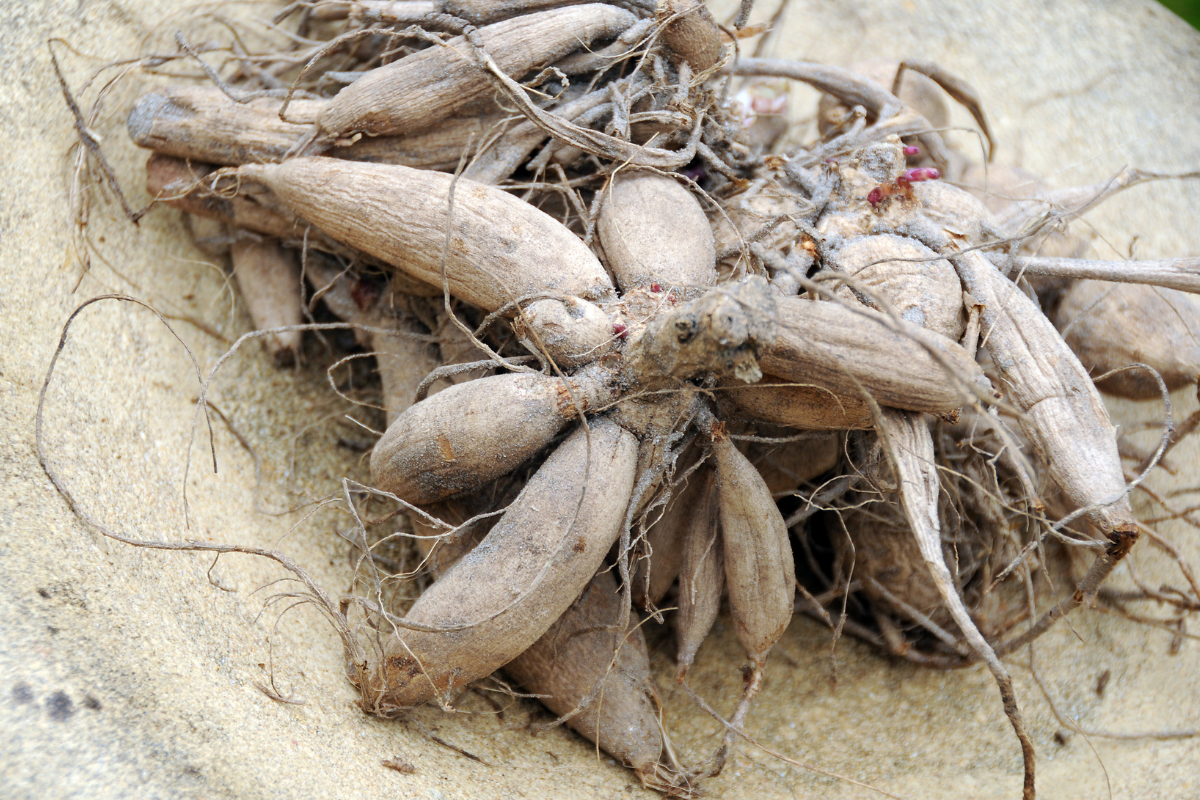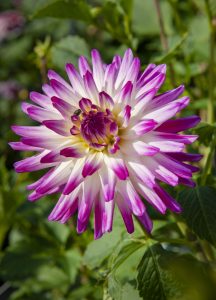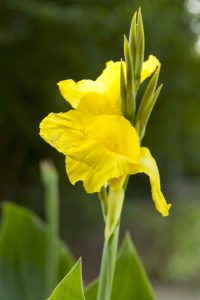
How to Store Dahlias, Cannas, and Callas
Once Autumn colours are at their peak and if the weather is mild, we can be tempted to leave our tender summer flowering bulbs in the ground just a little longer. Florissa knows we should be getting those tender bulbs – rhizomes, corms, and tubers – out of the ground and stored away for winter. The first light frosts, combined with yellowing and withering foliage are a sign that it is time. Of course, you don’t have to save tender bulbs for another season, as some gardeners prefer to buy new bulbs each spring, but if you discovered a bulb that delighted your heart, you might want to save and store it over the winter. Here’s how to handle those favourite tender bulbs.
Dahlias
 Dahlias dazzle us with their vast array of colours, forms, and bloom sizes. They’re an essential cut flower for summer bouquets. Enjoy their beauty in your garden until the plants experience the first hard-killing frost. Dahlias are frost sensitive and their foliage may turn brown with exposure, but frost hardens their tuberous tissues for winter storage. If you lift dahlia tubers out of the ground before the first hard frost, the tubers may sprout too early over the winter.
Dahlias dazzle us with their vast array of colours, forms, and bloom sizes. They’re an essential cut flower for summer bouquets. Enjoy their beauty in your garden until the plants experience the first hard-killing frost. Dahlias are frost sensitive and their foliage may turn brown with exposure, but frost hardens their tuberous tissues for winter storage. If you lift dahlia tubers out of the ground before the first hard frost, the tubers may sprout too early over the winter.
After the first hard frost, cut back plants so that the main stalk is 5 cm (2”) above the soil surface. For Dahlias only: leave the tubers in the ground for another week to allow the development of eye growth. Next spring, new plants will sprout from the eye growths that develop now. After a week’s time has passed, dahlia tubers can be lifted from the ground.
Begin to dig the soil at least 30 cm (12”) away from the main stalks of your tender clumps of tubers. Slowly and gently dig a wide and deep hole underneath and around them. Avoid causing any injury to the tubers underground.
Carefully lift the dahlia’s tuberous clump and free any excess soil by hand. You can do this over a wheelbarrow or bucket to conserve soil and return it to the garden. You can also wash dahlia tubers off with water from a garden hose, or leave them dirty, but do allow them to completely dry.
Florissa’s Tip!
Taking pictures of your dahlias or any summer blooms with your phone or digital camera can be helpful when it comes time to plant again next spring.
While you’re lifting tender summer bulbs it’s a great opportunity to reflect on your garden. Which varieties filled you with the most pleasure? Which combinations made spectacular bouquets? Is there a new variety you want to try growing next year? Did you learn something to help you grow more gorgeous flowers next season? Jot your notes down in a garden journal so that you don’t forget them. Tie a label tag with the variety name and colour of bloom to each tuberous clump, as they all tend to look alike once they’ve been lifted. Tender bulbs should be completely dry before storage. Space them out on a screen or tray so that there is good air circulation around them. A dark, dry shed or garage with temperatures of 16-20°C (60-70°F) and little exposure to sunlight is an ideal place to leave tender bulbs for four to seven days. This important period is called ‘curing’ and it allows the outer skins of tender bulbs to toughen up and survive the winter.
Store tender bulbs in single layers in an open top ventilated cardboard box placing a page of newspaper in-between layers. Breathable brown paper bags with ventilation holes, nylons, or cloth bags also work well for storage. Repurpose an empty onion sack. You can store tender bulbs in vermiculate if you desire. Keep the boxes in a cool, dry spot such as an unheated basement with consistent temperatures around 10°C (50°F) and good air circulation.
Canna Lilies
 Cannas are sought after for their lush tropical foliage and continuous summer flowers. Originating from the tropical climates of Asia, these tender bulbs won’t endure cold Canadian winters. It’s time to bring them in from the garden when overnight temperatures fall into the low, single digits.
Cannas are sought after for their lush tropical foliage and continuous summer flowers. Originating from the tropical climates of Asia, these tender bulbs won’t endure cold Canadian winters. It’s time to bring them in from the garden when overnight temperatures fall into the low, single digits.
Cannas don’t require a hard frost and can be lifted once the foliage begins to yellow or brown. Cut the plants back and gently dig the tender bulbs. Allow the rhizomes to dry and cure for four to seven days, then brush away any soil clinging to the thick storage roots by hand. Canna rhizomes are then ready for storage.
Gardeners often grow Cannas in large containers which makes them easy to store during the winter. Cut the plants back and leave the bulbs in the containers, allowing the soil to dry, and store the whole container in a cool, dark place that doesn’t freeze – a basement, shed or garage is ideal. In the spring, after the last frost, bring the containers outdoors, and carefully remove the rhizomes from the pot. Replant the firm pieces with growing eyes in fresh soil and then water for a new growth cycle to begin.
Florissa’s Tip!
Periodically check on tender summer bulbs through the winter. Remove and discard any bulbs that show signs of decay or mold. If bulbs appear shriveled or shrunken up, a light misting of water from a spray bottle will keep them from drying out too much. If you’re storing stacked containers, check them in late winter and again, in early spring for signs of new growth. Keep in mind when storing tender bulbs that they are living plants – just in a dormant state – so they may need a little attention through the winter.
Calla Lilies
 The elegant, long-lasting blooms of Calla Lilies appeal to many, as well as the attractive, smooth sword-like foliage that looks fabulous all summer.
The elegant, long-lasting blooms of Calla Lilies appeal to many, as well as the attractive, smooth sword-like foliage that looks fabulous all summer.
In their native South African habitat, Calla Lilies grow and flower during the wet season, and enter dormancy during the dry season. The best time to lift these tender bulbs is after the first hard frost has browned the foliage, ensuring the bulbs have a tough outer skin and fleshy interior with all the nutrients they need to survive the winter. Allow the bulbs to dry and cure for four to seven days and then brush away any remaining soil by hand.
Callas can also be stored in the containers in which they are grown, and if you have more than one container, stack the pots one on top of the other. Store the containers in a cool, dark spot that doesn’t freeze, and this will help prevent them from sprouting early.
Florissa’s Tip!
If you’ve been continuing to water and fertilize your potted amaryllis outdoors for the summer, now is the time to bring the bulb into a cool dark place indoors and allow it to rest for an 8-10 week period. Stop watering during this period and remove yellow and withered foliage. After resting, repot your amaryllis in fresh soil and bring it into the light and begin a new cycle of growth and blooms.
Comments:
Sorry, the comment form is closed at this time.



Rosemary
Good information, thank you. We don’t get killing frosts in the fall here in the Pacific Northwest, just heavy rains, and I’ve seen no difference in spring shoot production between dahlias I cut back and left for a week (with plastic over the tops of the stems) and those I’ve dug right away. And whether I divide in fall or spring, I have serious problems with finding the eyes. Any tips on that? I’ve even tried a magnifying glass!
Janet
I totally agree. I live in the Pacific Northwest also , and have given up looking for eyes. I just divide into small clumps, and plant. All my clumps are successful.
Rosemary
That’s good to hear–I’m new to this climate and to growing dahlias, but so far my guesses have worked also. I’ll stop fussing about it!